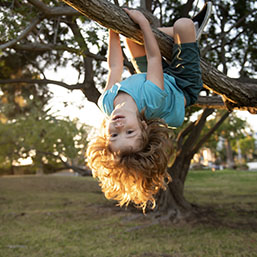
\n
I want you to think back to some of your fondest play memories as a child. Where were you? Who were you with? What were you doing? Chances are, if you were born in the 1990s or before, you were outside with your peers, not under adult supervision, and you were doing activities that today would be considered risky.
\n \nNow, I want you to think about the core skills you gained from those play activities; perhaps confidence, tenacity, and problem-solving. If we think about all of the valuable life skills we want to instill in our children – the same ones we gained from risky, outdoor play – how are we expecting our children to gain these skills if we are not allowing them the same play opportunities?
\nRisky play is defined as thrilling and exciting free play, where the outcome is uncertain and there is a possibility of injury. It is not hazardous or unsupervised play, but instead shows the children that they are capable and competent decision-makers. For instance, tree climbing would be considered risky play, as the child can choose how high they climb based on their comfort level, if they climb at all. Risky play, particularly outdoors, is essential for healthy child development. It allows children to develop risk assessment and management skills, flexible thinking, resilience, physical competence, and independence. Children are inherently wired to seek out risk where they can test their limits, feel a sense of freedom and excitement, and satisfy their curiosities. These experiences help them to develop critical thinking and coping skills for the challenges they will face throughout their lives.
\nSo, knowing that risky play helps children thrive, how do we allow it back into their lives? There are six main types of risky play – play at heights (tree climbing), play with speed (rolling down hills, biking), play with tools (hammers, saws), play near dangerous elements (fire, lakes), play with a chance of getting lost (exploring the forest, hide-n-seek), and rough-and-tumble play (tag, wrestling).
\nA great way to introduce risky play back into your child’s life is to get them back outside! Nature provides incredible opportunities to engage with risk – climbing over rocks, running up and down hills, sword fighting with sticks, climbing trees, and throwing rocks in the water. Given the time, space, and freedom to play the way children wish, risky play will almost always emerge. What we need to do is support it, rather than police it. We want to focus on the learning and development that is happening in the play, not necessarily our own comfort level or fears. In the words of Mariana Brussoni, “Children should be kept as safe as necessary, not as safe as possible.”
\nWhen children are engaging in risky play, we should stop ourselves from intervening automatically. We want to reflect on why we are stopping that play – is it because the child is actually in danger, or is it because what they’re doing is making us uncomfortable? If we intervene or stop the play entirely, we rob the child of the chance to solve problems and overcome the challenge themselves. You can start asking questions or offer comments to alleviate your concerns while encouraging critical thinking in the child. Do you feel safe? What is your next move? Before you throw that rock, what do you need to look for? Do you think you need more space? I’m here if you need me. Let’s check out that cave/fort to see if it’s safe to hide in.
\nWe want children to trust their own instincts, and gain confidence in their abilities, and we can do this by supporting them through risky play. It’s okay to be nervous or feel uncomfortable with risky play, especially if you weren’t exposed to it as a child. Let’s focus on the positive impacts that risk has on the mental and physical health of our children, and help them rediscover their wildhoods and thrive through risky play!
\n\n
Sarah has a Bachelor of Physical Education from the University of Alberta and was the supervisor for the City of Calgary’s Mobile Adventure Playground. As the owner of Playful Adventures (IG: @playfuladventures), she is passionate about bringing back unstructured, loose-parts, outdoor play. You can reach her at
\n
See our related articles:
\n
Calgary’s Child Magazine © 2025 Calgary’s Child